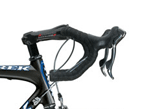
Figure 1:
Road or drop-type handlebar
The handlebar (Figure 1), the part you hold with your hands when riding a bicycle, is primarily responsible for your ability to steer and control the bicycle. In addition, the handlebar works with the seat to define your posture on the bicycle, adding comfort and efficiency to your cycling. Information on proper positioning of the parts is found in the section Fitting the bicycle. The handlebar is connected to the bicycle by the stem. Your handlebar also has grips that require inspection. This section explains how to inspect, adjust, and lubricate your handlebar.
Before performing any service work on your bicycle, read the Warning About Mechanical Work.
Some handlebars have marks on them that indicate they can be cut to a shorter length. This mark indicates the handlebar has reinforcement within the remaining area. Never cut the handlebar shorter than the mark allows. If the handlebar does not have such a mark, do not cut the handlebar. Cutting a handlebar shorter than the intended design can cause the handlebar to break when assembled or ridden.
Carbon handlebars are not compatible with clip-on type aerobars. Attaching a secondary bar to a carbon handlebar is a modification that could cause it to crack or break. Do not add aerobars to a carbon handlebar. In addition, some carbon handlebars are not intended to be used with bar-ends. Consult your dealer before adding bar-ends to (modifying) a carbon handlebar.
Warning—An improperly adjusted, tightened, or modified handlebar can cause you to lose control and fall. Make sure the handlebar is positioned and tightened properly before riding the bicycle. Do not modify the handlebar in any way.
|
|
Figure 1: Road or drop-type handlebar |
If you are unsure of the safety of your handlebar system, do not ride the bicycle; take the bicycle to your dealer for adjustments.
Before every ride, check the handlebar for signs of stress or fatigue.
Once a month test the security of the handlebar by attempting to rotate it in the stem. The handlebar should not move. When turning the handlebar side-to-side, make sure that no cables are stretched or pinched by rotating the handlebar. Make sure the grips cannot rotate. Some grips have a clamp bolt (Figure 2). Tighten the bolt to the torque specifications
Once a month check that all stem bolts are tightened to the torque specifications.
If your bicycle has a carbon fiber handlebar, also follow the carbon fiber composite inspection procedures.
To determine the best position of the handlebar, see Fitting the bicycle .
If your handlebar is made of carbon fiber composite, read about carbon parts compatibility before making any adjustments.
The position and angle of the handlebar is controlled by the stem.
Once a year, lubricate the stem.
To lubricate a stem or handlebar made of carbon fiber composite, read the section on Carbon Composite Inspection and Use.